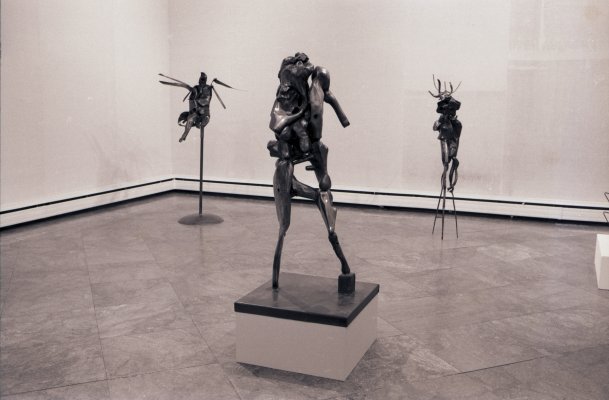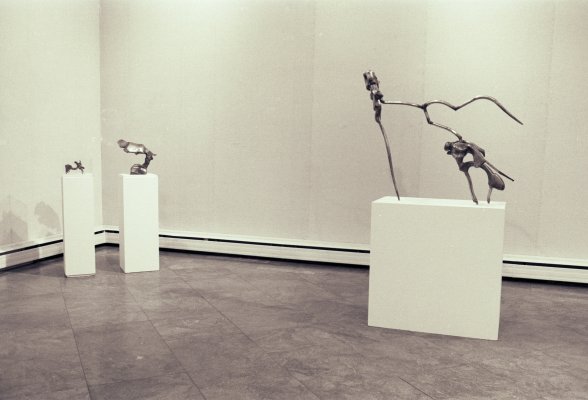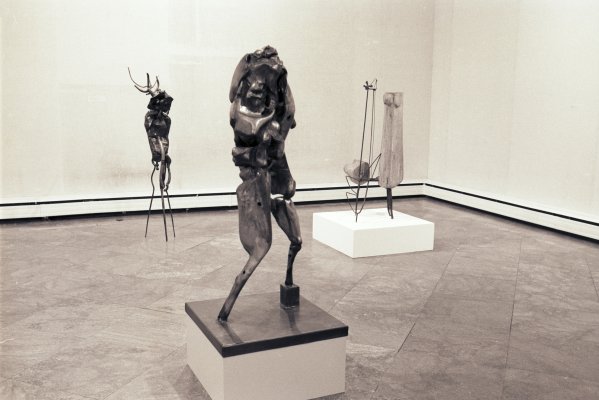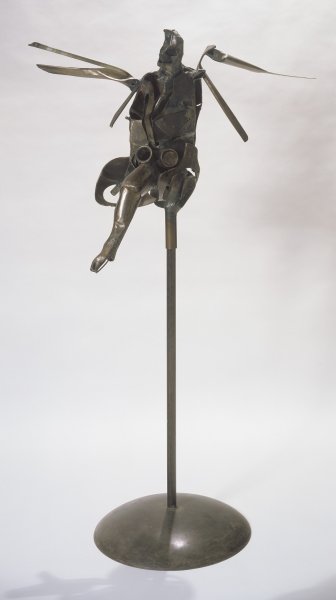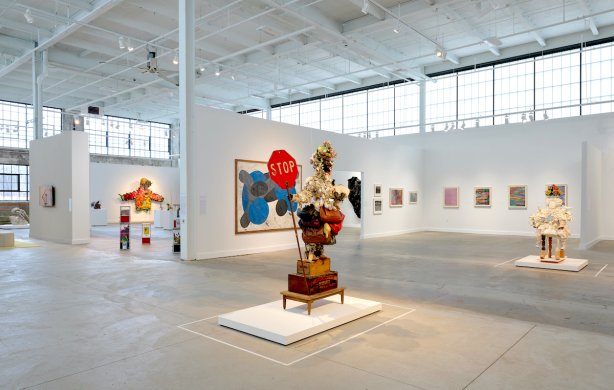Artist Richard Howard Hunt died one year ago today at the age of 88. The sculptor, famous for his metal abstractions, was a titan in the art world. He undertook the laborious work of shaping and welding metal for seven decades up until just about the day he died. One of Hunt’s sculptures is currently on view in the Wilmers Building, but he’s had a long history with the Buffalo AKG. Several of Hunt’s sculptures were featured in In These Truths an exhibition at Albright-Knox Northland in 2021 of twenty-one living Black artists. Before even that, Hunt was featured in the first show of all Black artists that the Albright-Knox ever produced. Curated by guest curator Beryl Wright, The Appropriate Object featured seven contemporary artists. In the catalogue for the show, Wright interviewed Hunt about his work. In celebration of Hunt’s incredible legacy, we are republishing that interview here.
Beryl Wright: From the late 1950s to about 1965, you explored two different approaches to welded metal: first, in what you have described as sculpture, in which “subject is conceived in the most general terms and derives from an observation of the formal and spatial contents of organic and machine structure,” and second, an approach aimed at showing “definite image-consciousness and often specific subject matter.”
Richard Hunt: That work was part self-expression and part advanced study of sculpture in terms of direct metal construction. There were some pieces that I was constructing using wood and metal which were confined to the years 1956 to 1957. After that, I decided to concentrate on metal, using both the more figure-derived and developed pieces and the linear pieces, but to do them all in metal as a way of being able to more freely explore the spatial and construction related considerations. I was interested in greater freedom and fluency with the medium at the time. I felt that by simplifying the means, reducing it to just working with metal, that was a way of opening it up for me.
BW: With the earlier pieces like Construction N, 1956, you used a combination of materials and found objects. How did the sculpture change as a result of simplifying the means?
RH: If you’re creating a figure or an object that has some relationship to the real world, you end up having the material relate to some sort of idea. But if you create a context through the spatially extended deployment of elements, things drawn from nature can take on a different relationship to one another and hint at meaning that is multiple rather than singular. Elements become like something, but they can also be like something else. Animating those linear pieces through the technique of extension — drawing in space — creates a spatial context in which heterogeneous and diverse things can come together, mingle, yet remain separate.
BW: Despite the diversity of sources and materials used, one of the overriding effects of your early work is a sense of balance among all of the elements.
RH: Balance was always something that was interesting to me — either implying it or actually achieving it. In the vertical linear pieces, I would shift the elements one way or another so that they could be very thin, but stand on a rather small base. Part of the vitality of the piece had to do with achieving that balance within the forms. Generally, those pieces would have legs or some kind of thin supports and then the rest of the material would be structured in a way that it would seem to rest rather lightly on the supports. That was all part, too, of exploiting the tensile strength of the steel, along with implying movement, but having enough stability to the structure to keep it intact and upright.
BW: In combining the cottonwood with the tubular steel, you brought all of these diverse elements together, but you've ended up with something that seems to have a structural logic to it.
RH: I think that there was, and I guess there still is, a fanciful structural logic developed in these forms that have a unity and vitality — a life of their own — like any organism made up of diverse material, minerals or the various compounds that go into making something. A fingernail is not skin, but it looks like it ought to grow out of the end of a finger, even though it's got a different texture and a different color tone. The elements of a sculpture don't perform practical functions like a fingernail does, but you can put these things together and in the right kind of composition, they can animate one another. An ongoing general theme for me is reconciling an interest I have in nature and industry. At one point, I was working with different materials — wood, which is organic, and metal, which actually is organic, if you look beyond its application to industry. It comes out of the ground — it's really earth. I go beyond the common perceptions that we have about materials and combine them in a way that makes them seem compatible.
BW: The works of the 1950s and early 1960s have a very lyrical and vitalist quality to them, first, because of the way you've combined diverse elements to create objects with their own internal logic, and second, through the spatial extension of materials and forms.
RH: I've always felt that works of art should be artful. While there are certainly things one can express in a more brutalistic or ugly way, I’d rather leave that to somebody else.
BW: How did you become interested in working with materials in this way?
RH: I saw work in a show that was very important to me — Sculpture of the 20th Century, which was touring and came to the Art Institute [of Chicago] in the early fifties. I saw a couple of [Julio] González pieces — the Monserrat with hammered metal, and one of the linear heads called The Snail. There were pieces of Picasso's like the model for the Monument to Apollinaire — the drawing kind of things, and some of the British sculptors that were getting a lot of attention at the time like Reg Butler and [Lynn] Chadwick, who had started to work with metal. That all interested me, particularly the work of González.
BW: Why was González so important?
RH: At first sight, I really just liked the way he handled the material. The Monserrat was a figure piece and the hammered, shaped metal form seemed an interesting way to move from the figurative work that I'd been doing. I was also interested in the linear aspects of The Snail. And then Picasso, of course. I was interested in the fact that González worked with him on those things, started to investigate all of those relationships. And then David Smith. I’d been interested in his work. There were also a couple of sculptors here — Joe Goto, who had been working with very thin, attenuated forms, and Ray Fink, who I ended up taking a class with at the Art Institute. But it was all about having an interest in moving beyond modeling. That was certainly an important juncture because I saw those things and began to see the work of local people who had gotten some of the same inspiration. But González summed it all up when he described the new sculpture as the marriage of material and space.
BW: Did the figure constructions develop from seeing the Monserrat?
RH: Actually, the more figurative things in metal were just part of a way of developing as a sculptor in metal. I was both teaching myself something about working with metal and applying that to various approaches to form in direct metal construction. The kinds of forms I emulated, whether they were called antique studies, hybrid forms or figure constructions, were just different ways of approaching it. There were times when I had all these different kinds of pieces in the studio. I'd work on one in the morning and one in the afternoon. I'd make a piece out of wood and steel, and a linear piece out of found objects, and another more figurative piece concurrently. So in that period from 1955 to, say, 1960, you would see a lot of those works over-lapping in time.
BW: Over the past thirty years, you have used a consistent set of themes in your sculpture and there is an overall consistency in your approach to subject matter in its reference to things from the real world.
RH: I always see in something abstract something drawn from nature or another subject area. Without being specific, it could relate to subject areas or feelings and be potentially more expressive of a range of things. One of the ways I've evolved was to construct sculptures in a way that gave the possibility of interpreting the piece through the association of certain ideas with other ideas. Working with various levels of abstraction and combinations allows me to build up a variety of associations within a sculpture.
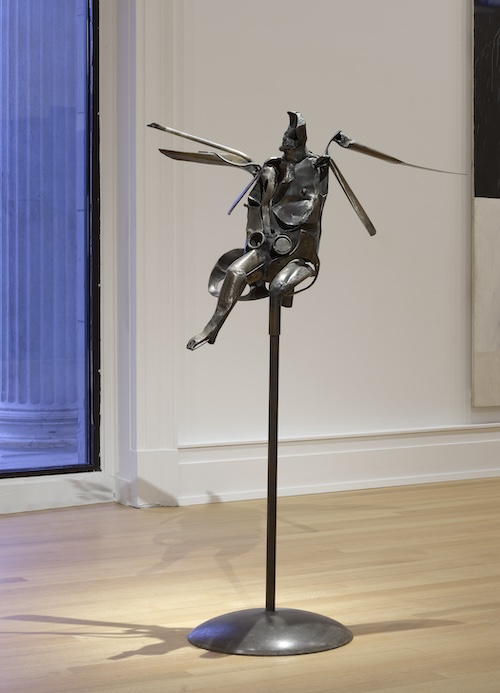
BW: One image that is associated with your work is a winged motif, which has been used at various levels of abstraction for a long time. What is the significance of the winged forms for you?
RH: I don't have a ready explanation for their appearance and re-appearance, but I am fascinated with flight, either the flight of birds or airplanes. I did an earlier series which included studies of, or variations on, Winged Victory or Nike themes, so there are a variety of ways in which they appear. I've had an interest in airplane wings and fuselages as twentieth-century examples of metal-working — just like armor was an example of medieval ironwork. Creating form in response to a specific program is something that's very interesting to me — the development of airplanes from Kitty Hawk on.
BW: So, your interest in this image is again related to a structural context?
RH: I don't think about sculpture as divorced from how it's made. Sculpture is an idea and a process. So, since at a certain point in time I decided to work with metal, it just interests me to look at things made out of metal. I get ideas from looking at the way things are made. I fly a lot of places and I like to sit in the window so I can look out. If I sit by the wing, lots of times I take pictures. It's nice if you’re sitting there when you land and the flaps go up on a 747 or a DC-10. But the wing form is also something that works well to express expansiveness or uplifting. And it's easy to make the connotations between something natural and something industrial, because we're so used to seeing wings on airplanes and birds in flight.
BW: Because your work seems to be very improvisational, are there pieces that you've worked on with your objectives very clear that didn't develop in the way you had expected?
RH: Well, it is improvisational. One of the things that I liked about the direct metal technique was that you can put things together and take them apart. It's not like carving something, where if you do it that way, that's the way it is. With any of the pieces that I've done, there's always the possibility of welding something together, cutting off a part of it, re-positioning it. There's a fluidity or open-endedness of the approach that I find very appealing, because it does leave open the possibility of change in the development of the piece — adding things, taking things away.
BW: Your early work is often linked to Abstract Expressionism or Surrealism — to artists like Theodore Roszak and Seymour Lipton. Is this the context in which you see your work?
RH: I see my work generally in that kind of context. I certainly was interested in Surrealism. As you know, there was a lot of interest in Chicago on the part of artists and collectors in all of the Surrealists. As a matter of fact, during my school days at the Art Institute there were visiting artists like [Roberto] Matta and Roszak and Kurt Seligmann, and their work was influential too. Matta's linear style was of interest to me. I was interested in Roszak's approach to steel, but it was a little too heavy for me. And his ideas were a little too heavy for me.
BW: What do you mean by “heavy”?
RH: He was more philosophical. He had a tragic view of man and his place in history and the world. One saw it as a very intellectual approach to sculpture.
BW: How does that differ from your approach?
RH: It doesn't draw out the imagery from other sources in the same way. I’m interested in a lot of things — literary, historical. But when I work, I turn away from those things. That’s not to say that on an unconscious level a lot of things don't become part of the work. But I think the content of the sculpture will take care of itself. I have created an environment in my studio and in my head which facilitates the production of things that could be called “sculpture.” I don't start out saying, “My goal as a sculptor is to create images that will bring together things from my past or relate to my identity.” You can do it that way, but I don't think that I have to do it that way. One becomes aware when looking at art from other times and places that people just did it. If you were a sculptor in Egypt, you didn't have to create a whole thing about what your art was going to mean before you got started.
BW: You mentioned that you have had a specific interest in the history of metal-working. How has that affected your approach to construction methods or subject matter?
RH: I mentioned earlier how process and ideas are linked in producing things. I have as much fascination with the history of metal-processing, as I have with the history of ideas and of art, and with pre-industrial technology. When I started to buy African objects about twenty years ago, I began to accumulate a lot of works of cast, forged and fabricated metal, especially iron. That led to a casual study of the history of iron in sub-Saharan Africa along with a casual study of the history of metal-working everywhere else in the world. One of the more interesting insights drawn from this study is that of the ritualization of the processes of making and forming objects in iron. The empirical discovery of the processes gave to certain people an uncommon power, which they jealously guarded and exploited by associating rites with manufacture and imbuing objects with supernatural power. Keeping the process secret helped those in power retain power.
BW: Prior to this interest in pre-historic fabrication of metal, you were primarily interested in industrial processes.
RH: As my technique evolved from the early pieces in which I was combining materials, one aspect of that evolution was that I related my way of producing sculpture to industrial methods of producing objects from metal. There's an infinite variety of things that are produced by processing sheets of metal in various ways — rolling them into tubes, stamping them into shapes, taking big pieces of metal and making a bridge out of them, or taking a thin piece of metal and making a wing section of a plane out of it. I find a great deal of creativity in these industrial processes.
BW: Your work took on a definite change around 1965. The works increased in scale and mass, and the set of structural relationships was simplified. What happened at this time that affected your work?
RH: In 1964 I was invited to teach at the California Institute of the Arts and to be an artist fellow at Tamarind Workshop in Los Angeles. I spent about a year out there and started working in a new studio. In the case of sculpture, which puts things together, you create an environment within the studio with the materials you bring in. Whether it's new material or things that you find, it's been selected with at least some notion of fitting into the context of a single piece; or it forms part of an ongoing material, sculptural dialogue. I didn't take any of that out to California. I started in the environment of this studio to work with other combinations of volumes — chrome automobile parts, bumpers and linear elements related to them. When I returned from California in late 1965, I got involved in working with the beginnings of some of the large-scale commission pieces.
BW: Obviously, with the change in scale, you had to find a different way of working.
RH: When I started to work on a piece called Play, I got involved in working in a welding, fabricating shop — more of a factory context — where I had iron workers, people with careers in metal-working, assisting me. I started to think about the relationship of Play to the environment, to the architecture and to what I could carry over of my studio methods into this other way of working in the shop, which was not altogether self-determined. One of the things was to exploit the planar possibilities. First, I started to work with Cor-Ten steel and later with bronze sheets and plates, but using sheets and plates to develop a form rather than tubes and the found things that I had been using. So that represented a change in the character of some of the sculpture. Another reason for the change in scale at this time was that I've always been responsive to the kind of physical context within which my work ends up being placed. While I found those earlier pieces very interesting, if you saw one of the linear, open form pieces in a group show like the Whitney Annual or Carnegie International, they would tend to get lost. There was a certain preciousness about them. So making things that had a little more presence in terms of their volume, but still had some of the same genesis in terms of the kind of formal and structural characteristics, seemed an interesting evolution. I’ve not been interested in just pursuing something and pursuing it just because I wanted to pursue it. Linearity, after a while, did not seem that important. New possibilities develop in the life of one's career and they're interesting too. The formal development of my sculpture doesn't follow inner necessity as much as it does opportunity or possibility.
Beryl Wright (American, 1948–2000) was an influential curator who specialized in twentieth century African American art. She served as a curator at the Newark Museum and was the first African American curator at the Museum of Contemporary Art in Chicago. She was one of the first art historians to champion the work of Lorna Simpson and her research was vital to sparking interest in Harlem Renaissance painting. However, Wright struggled in her professional life against persistent racial discrimination and her own life ended tragically. She was herself the subject of a painting by Kerry James Marshall. Learn more about Wright here.
